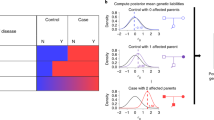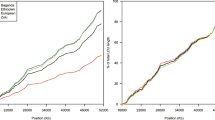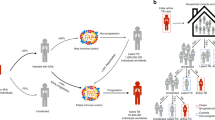Abstract
Leprosy is a chronic disease caused by infection with Mycobacterium leprae, which is manifested across a wide clinical spectrum. There is evidence that susceptibility both to leprosy per se and to the clinical type of leprosy is influenced by host genetic factors. This paper describes the application of an identity by descent regression search for genetic determinants of leprosy type among families from Karonga District, Northern Malawi. Suggestive evidence was found for linkage to leprosy type on chr 21q22 (P<0.001). The methodological implications of the approach and the findings are discussed.
This is a preview of subscription content, access via your institution
Access options
Subscribe to this journal
Receive 6 digital issues and online access to articles
$119.00 per year
only $19.83 per issue
Buy this article
- Purchase on Springer Link
- Instant access to full article PDF
Prices may be subject to local taxes which are calculated during checkout


Similar content being viewed by others
References
WHO. Leprosy global situation. Weekly Epidemiol Rec 2002; 77: 1–8.
Bryceson A, Pfaltzgraff RE . Leprosy 1990;Churchill Livingstone: New York.
Mira MT, Alcas A, Thuc NV et al. Chromosome 6q25 is linked to susceptibility to leprosy in a Vietnamese population. Nat Genet 2003; 21: 412–415.
Tosh K, Meisner S, Siddiqui R et al. A region of chromosome 20 is linked to leprosy susceptibility in a South Indian population. J Infect Dis 2002; 186: 1190–1193.
Siddiqui R, Meisner S, Tosh K et al. A major susceptibility locus for leprosy in India maps to chromosome 10p13. Nat Genet 2001; 27: 439–441.
Blackwell JM . Modern genetics and leprosy susceptibility. Lepr Rev 2001; 72: 352–356.
Shaw M, Donaldson IJ, Collins A et al. Association and linkage of leprosy phenotypes with HLA class II and tumour necrosis factor genes. Genes Immun 2001; 2: 196–204.
Roy S, Frodsham A, Hazra SK, Mascie-Taylor CGN, Hill AVS . Association of vitamin D receptor genotype with leprosy type. J Infect Dis 1999; 179: 187–191.
Van Eden W, Gonzalez NM, de Vries RRP, Convit J, van Rood JJ . HLA-linked control of predisposition to lepromatous leprosy. J Infect Dis 1985; 151: 9–14.
van Eden W, de Vries RRP, Mehra NK, Vaidya MC, D'Amaro J, van Rood JJ . HLA segregation of tuberculoid leprosy: confirmation of the DR2 marker. J Infect Dis 1980; 141: 693–701.
Abel L, Sánchez FA, Oberti J et al. Susceptibility to leprosy is linked to the human NRAMP1 gene. J Infect Dis 1998; 177: 133–145.
Meisner SJ, Mucklow S, Warner G, Sow SO, Lienhardt C, Hill AVS . Association of NRAMP1 polymorphism with leprosy type but not susceptibility to leprosy per se in West Africans. Am J Trop Med Hyg 2001; 65: 733–735.
Santos AR, Almeida AS, Suffys PN et al. Tumor necrosis factor promoter polymorphism (TNF2) seems to protect against development of severe forms of leprosy in a pilot study in Brazilian patients. Int J Lepr Other Mycobact Dis 2000; 68: 325–327.
Roy S, McGuire W, Mascie-Taylor C et al. Tumor necrosis factor promoter polymorphism and susceptibility to lepromatous leprosy. J Infect Dis 1997; 176: 530–532.
Shaw MA, Collins A, Peacock CS et al. Evidence that genetic susceptibility to Mycobacterium tuberculosis in a Brazilian population is under oligogenic control: linkage study of the candidate genes NRAMP1 and TNFA. Tubercle Lung Dis 1997; 78: 35–45.
Job CK . Genetics and leprosy. Lepr India 1980; 152: 353–358.
Fine PEM . Implications of genetics for the epidemiology and control of leprosy. Phil Trans R Soc Lond Ser B 1988; 321: 365–376.
Pönnighaus J, Fine PE, Bliss L et al. The Lepra Evaluation Project (LEP) and epidemiological study of leprosy in northern Malawi. I: methods. Lepr Rev 1987; 52: 359–375.
Fitness J, Siddiqui R, Wallace C et al. No evidence for a major locus for leprosy susceptibility on chr10p13 in Karonga District, Malawi. (in preparation) .
Holmans P . Detecting gene-gene interactions using affected sib pair analysis with covariates. Hum Hered 2002; 53: 92–102.
Hogg N, Stewart MP, Scarth SL et al. A novel leukocyte adhesion deficiency caused by expressed but nonfunctional β2 integrins Mac-1 and LFA-1. J Clin Invest 1999; 103: 97–106.
Casanova J-L, Abel L . Genetic disection of immunity to mycobacteria: the human model. Annu Rev Immunol 2002; 20: 581–620.
Fitness J, Tosh K, Hill AVS . Genetics of susceptibility to leprosy. Genes Immun 2002; 3: 441–453.
Pönnighaus JM, Fine PEM, Bliss L . Certainty levels in the diagnosis of leprosy. Int J Lepr Other Mycobact Dis 1987; 55: 454–462.
Rice JP, Rochberg N, Neuman RJ et al. Covariates in linkage analysis. Genet Epidemiol 1999; 17: S691–S695.
Huber PJ . The behaviour of maximum likelihood estimates under non-standard conditions. In Proceedings of the Fifth Berkley Symposium on Mathematical Statistics and Probability Vol. 1, University of California Press: Berkley, CA, 1967: 221–233.
White H . Maximum likelihood estimation of misspecified models. Econometrica 1982; 50: 1–25.
White H . A heteroskedasticity-consistent covariance matrix estimator and a direct test for heteroskedasticity. Econometrica 1980; 48: 817–830.
Royall RM . Model robust confidence intervals using maximum likelihood estimators. Int Stat Rev 1986; 54: 221–226.
StataCorp. Stata Statistical Software: Release 8 2003; Stata Corporation: College Station, TX.
Clayton D, IBDREG. http://www-gene.cimr.cam.ac.uk/clayton/software/stata/README.txt, 2002.
Acknowledgements
The data analysed here were collected within the context of the Karonga Prevention Study (KPS), which has been supported by the British Leprosy Relief Association (LEPRA) and the Wellcome Trust, with contributions from the International Federation of Anti-Leprosy Organisations (ILEP) and the WHO/UNDP/World Bank Special Programme for Research and Training in Tropical Diseases. We acknowledge the special contributions of Dr AC Crampin, and more than 50 field staff for the fieldwork, and the National Health Sciences Research Committee of Malawi for encouraging the KPS programme. We thank Dr Ruby Siddiqui for helpful comments. CW was supported by the British Medical Research Council.
Author information
Authors and Affiliations
Corresponding author
Rights and permissions
About this article
Cite this article
Wallace, C., Fitness, J., Hennig, B. et al. Linkage analysis of susceptibility to leprosy type using an IBD regression method. Genes Immun 5, 221–225 (2004). https://doi.org/10.1038/sj.gene.6364062
Received:
Revised:
Accepted:
Published:
Issue Date:
DOI: https://doi.org/10.1038/sj.gene.6364062
Keywords
This article is cited by
-
Human genetics of mycobacterial disease
Mammalian Genome (2018)
-
Genetic variants of the MRC1 gene and the IFNG gene are associated with leprosy in Han Chinese from Southwest China
Human Genetics (2012)
-
Genetic and functional analysis of common MRC1 exon 7 polymorphisms in leprosy susceptibility
Human Genetics (2010)



